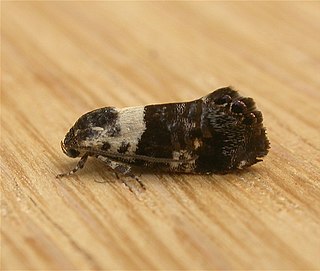
The Bird’s Wing(Dypterygia scabriuscula) is a moth of the family Noctuidae. The species can be found in Europe and the western Palearctic.

Eupselia aristonica is a species of moth of the family Depressariidae. It is found in Australia, where it has been recorded from New South Wales, the Australian Capital Territory, Victoria and Tasmania.

Trichoptilus ceramodes is a moth of the family Pterophoridae that is found in Australia, including New South Wales and South Australia.
Ichneutica omoplaca is a moth of the family Noctuidae. It is endemic to New Zealand. It is widespread from the Bay of Plenty in the North Island down to Southland in the South Island. Specimens have also been collected from the Auckland Islands. It lives in a variety of habitats including beech forest clearings and tussock grasslands. This species has been recorded that some of the larval hosts of this species include Poa cita, Dactylis glomerata and it has been reared on Plantago lanceolata. The larva is undescribed but pupae have been found in a pine plantation in soil under weeds. Adults of this species are on the wing from October to March. The adult moths are variable in appearance but the diagnostic feature is the pale ochreous to white colouring between the basal streak and the costa which contrasts with the ground colour of the forewing.
Metasia strangalota is a moth in the family Crambidae. It was described by Edward Meyrick in 1887. It is found in Australia, where it has been recorded from New South Wales.
Nacoleia mesochlora is a moth in the family Crambidae. It was described by Edward Meyrick in 1884. It is found in Australia, where it has been recorded from Queensland, the Northern Territory, New South Wales, Victoria, South Australia and Western Australia.
Syllepte cometa is a moth in the family Crambidae. It was described by William Warren in 1896. It is found in Assam, India.
Tabidia inconsequens is a moth in the family Crambidae. It was described by William Warren in 1896. It is found in India and Australia.
Tylostega valvata is a moth in the family Crambidae. It was described by William Warren in 1896. It is found in the Khasi Hills of India.
Nordstromia humerata is a moth in the family Drepanidae. It was described by Warren in 1896. It is found in north-eastern India.
Epipsestis castaneata is a moth in the family Drepanidae. It was described by Warren in 1915. It is found in Sikkim in India, Hunan in China and in Nepal and Vietnam.
Takapsestis orbicularis is a moth in the family Drepanidae. It is found in India.
Dichomeris ligyra is a species of moth in the family Gelechiidae. It was described by Edward Meyrick in 1913. It is found in Gauteng, South Africa.
Aristotelia pyrodercia is a moth of the family Gelechiidae. It was described by Walsingham in 1910. It is found in Mexico (Guerrero).
Dorycnopa marmorea is a moth of the family Gelechiidae. It was described by Oswald Bertram Lower in 1899. It is found in Australia, where it has been recorded from New South Wales.
Autosticha demias is a moth in the family Autostichidae. It was described by Edward Meyrick in 1886. It is found on Fiji.
Stenoma platyterma is a moth of the family Depressariidae. It is found in Guyana.
Eupselia theorella is a moth in the family Depressariidae. It was described by Edward Meyrick in 1880. It is found in Australia, where it has been recorded from New South Wales.
Antaeotricha lecithaula is a species of moth in the family Depressariidae. It was described by Edward Meyrick in 1914. It is found in Guyana.

Ichneutica paracausta is a moth of the family Noctuidae. This species is endemic to New Zealand. It is found locally in the central North Island, is widespread in the South Island and can also be found in Stewart Island. I. paracausta is variable in colour, but as it has a distinctive black streak on its forewing as well as a wing pattern that is characteristic, I. paracausta is unlikely to be confused with other species. It is present on the North Island volcanic plateau as well as Little Bush Reserve in Hawkes Bay in the North Island as well as in tussock grassland, alpine and subalpine shrubland and in alpine forest. Larvae have been recorded as feeding on grasses, a pupa has been found in a cocoon under the bark of a tree and adult moths are on the wing from October to January.



